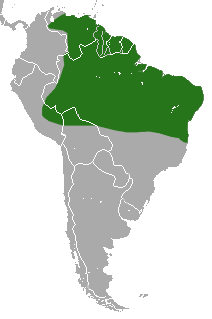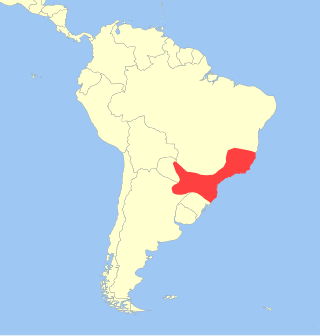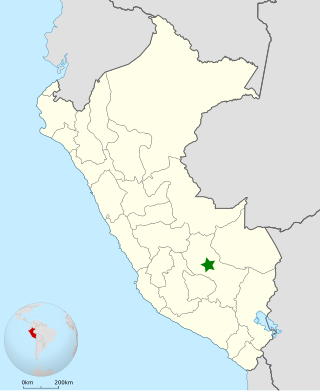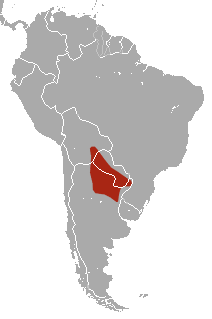
Armadillos are New World placental mammals in the order Cingulata. They form part of the superorder Xenarthra, along with the anteaters and sloths. 21 extant species of armadillo have been described, some of which are distinguished by the number of bands on their armor. All species are native to the Americas, where they inhabit a variety of different environments.

The woolly mouse opossum or long-furred woolly mouse opossum, known locally as the cuíca, is a South American marsupial of the family Didelphidae. Its range includes central Colombia, Venezuela, French Guiana, Guyana, Suriname, eastern Peru, northern Bolivia, and northern Brazil. It was formerly assigned to the genus Micoureus, which was made a subgenus of Marmosa in 2009.

The greater long-nosed armadillo is a South American species of armadillo found in Colombia, Venezuela, Ecuador, Guyana, Suriname, French Guiana, Peru, Bolivia and Brazil. It is a solitary, nocturnal, terrestrial animal that feeds on arthropods and other invertebrates, usually living in the vicinity of streams and swamps.

The seven-banded armadillo, also known as the Brazilian lesser long-nosed armadillo, is a species of armadillo from South America found in Paraguay, Argentina, Bolivia and Brazil. It is a solitary nocturnal, terrestrial animal, living mostly in dry habitats, outside of rainforest regions.

The southeastern four-eyed opossum is an opossum species native to South America. It is found in Atlantic Forest ecoregions, in Brazil, Paraguay and Argentina.

Anderson's four-eyed opossum is an opossum species from South America. It is found in Brazil, Colombia, Ecuador, Peru and Venezuela. Its dorsal fur is dark, with a black stripe, about 3–4 cm wide, going vertically down the midline of its back. Its dorsal fur is short, about 10 mm long. Its ventral fur is dark gray, but still distinctly lighter than the sides and dorsum. Its tail is furred for the first (approximately) 18% of its length, going from the base to the tip. Its species name "andersoni" was chosen to honor American scientific collector Malcolm Playfair Anderson.

The dwarf fat-tailed mouse opossum, also known as the velvety fat-tailed opossum is an opossum species from South America. It is endemic to Brazil, where it is found in cerrado and caatinga habitats. Its head-and-body length is about 141-212 mm, and its tail length is about 73-85 mm. Its diet is 44% arthropods; 75% of its diet consists of animals and animal products. Its ventral fur is entirely gray-based. Its hind foot is less than 14 mm, which is short for the genus.

The white-throated round-eared bat is a bat species found from Honduras to Bolivia, Paraguay and Brazil. It creates roosts inside the nests of the termite, Nasutitermes corniger. It thrives on a mainly insect-based diet, focusing on the surfaces of foliage to hunt, and also eats fruit and pollen. It has a very wide range and is a common species over much of that range, so the International Union for Conservation of Nature has assessed its conservation status as being of "least concern".

The Incan little mastiff bat is a species of bat in the family Molossidae, the free-tailed bats. It belongs to the subgenus Micronomus.

The Paraguayan fat-tailed mouse opossum is a species of opossum in the family Didelphidae. It is found in forested areas of Brazil and Paraguay. It is known only from a few specimens. For two listed specimens, one had a head-and-body length of about 135 mm and a tail length of about 140 mm, while the other had a head-and-body length of about 120 mm and a tail length of about 155 mm. Most of its fur is gray, but the shoulder areas are reddish gray, and the ventral fur is pure white or creamy white. There is also a ring of black fur surrounding each eye. The ventral surface of the tail is white. The dorsal surface of the tail is gray for the first one third to one half of its length ; the remainder of the dorsal surface of the tail is white. The tail is hairless except for about its first ten mm. Although the genus Thylamys is characterized by fat storage in the tail, there is no evidence that this species stores fat in its tail.

The common fat-tailed mouse opossum is a species of opossum in the family Didelphidae. It occurs in Argentina, Bolivia, and Paraguay in chaco and Andean foothill habitats. Its head-and-body length is about 75 to 120 mm, and its tail length is about 90 to 134 mm. Its dorsal fur is brownish gray, and its ventral fur is yellowish to white. The legs and cheeks are the same color as the ventral surface. Its tail is sharply bicolored. A ring of faintly darker fur surrounds each eye. Its tail often lacks fat deposits, but does not always.

The gray-bellied caenolestid, or grey-bellied shrew opossum, is a shrew opossum found in humid, temperate forests and moist grasslands of western Ecuador and northwestern Peru. It was first described by American zoologist Harold Elmer Anthony in 1921. Little is known about the behavior of the gray-bellied caenolestid. It appears to be terrestrial (land-living) and crepuscular or nocturnal. Diet consists of invertebrate larvae, small vertebrates and plant material. The IUCN classifies the gray-bellied caenolestid as near threatened.

The Incan caenolestid, also known as the Incan shrew opossum or Peruvian caenolestid, is a caenolestid found in the southern Peruvian Andes. It was first described by English zoologist Oldfield Thomas in 1917. The head-and-body length ranges from 9 to 11.5 centimetres, and the weight is between 25 and 32 grams. It is brown on the back, and lighter on the underside. Little is known about the behaviour of the Incan caenolestid; it appears to be terrestrial and nocturnal. It feeds on small invertebrates and insects. This caenolestid inhabits elfin and secondary forests. The IUCN classifies it as least concern.

The Llanos long-nosed armadillo or northern long-nosed armadillo is a species of armadillo in the family Dasypodidae. It is endemic to Colombia and Venezuela, where its habitat is the intermittently flooded grassland of the Llanos. The species is closely related to the nine-banded armadillo and the great long-nosed armadillo. It has very little hair and can weigh up to 22 pounds (9.5 kg), and can grow to about 2.1 feet (60 cm) long. It lives in dense cover near limestone formations. Like most other armadillos, it eats ants.

Mono's short-tailed bat is a leaf-nosed bat species found in Colombia and Panama. Specimens have been collected in habitats ranging from dry to tropical rain forest at elevations ranging from 30 to 2,660 metres.

The saddle-back tamarins are squirrel-sized New World monkeys from the family Callitrichidae in the genus or subgenus Leontocebus. They were split from the tamarin genus Saguinus based on genetic data and on the fact that saddle-back tamarins are sympatric with members of Saguinus to a greater extent than would be expected from two members of the same genus. However, this argument can be circular, as several other mammals show sympatry among congeneric species, such as armadillos, spotted cats, and fruit-eating bats. Some authors still consider Leontocebus to be a subgenus of Saguinus.

The Peruvian Yungas comprise a tropical and subtropical moist broadleaf forest ecoregion in Peru.




















